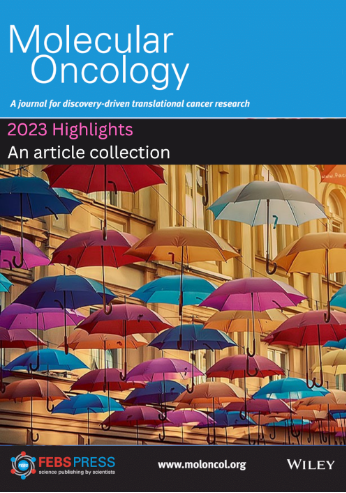预测癌症新辅助化疗的动态反应:一种新的代谢组学方法
IF 5
2区 医学
Q1 ONCOLOGY
引用次数: 2
摘要
新辅助化疗(NACT)的结果因癌症(BC)亚型而异。由于病理完全反应是NACT最重要的目标终点之一,因此进一步研究BC的NACT结果至关重要。因此,确定 对每种表型的治疗反应将能够早期发现化疗耐药性和残余疾病,减少对无效治疗的暴露,提高总生存率。我们使用基于液相色谱-高分辨率质谱(LC‐HRMS)的非靶向代谢组学来检测相同NACT方案后三种不同BC亚型血浆中的分子变化,目的是寻找潜在的反应预测因素。代谢组学数据集通过单变量和多变量统计策略相结合进行分析。通过使用方差分析-同时成分分析(ASCA),我们能够确定三阴性(TN)亚型对NACT反应的潜在候选生物标志物的预后价值。在应答组的基础样本和术前样本中分别发现较高浓度的二十二碳六烯酸和仲胆汁酸。此外,甘胆酸和甘脱氧胆酸能够根据对治疗的反应和总生存率对TN患者进行分类,并使用曲线下面积模型 > 0.77.关于管腔B(LB)和HER2+受试者,应注意的是,显著差异与时间和个体因素有关。具体而言,HER2+患者的色氨酸随着时间的推移而减少,而LysoPE(22:6)似乎增加,但与NACT反应无关。因此,将基于非靶向的代谢组学与纵向统计方法相结合,可能是改善治疗和在临床实践中进行更个性化的BC随访的一个非常有用的工具。本文章由计算机程序翻译,如有差异,请以英文原文为准。
Predicting dynamic response to neoadjuvant chemotherapy in breast cancer: a novel metabolomics approach
Neoadjuvant chemotherapy (NACT) outcomes vary according to breast cancer (BC) subtype. Since pathologic complete response is one of the most important target endpoints of NACT, further investigation of NACT outcomes in BC is crucial. Thus, identifying sensitive and specific predictors of treatment response for each phenotype would enable early detection of chemoresistance and residual disease, decreasing exposures to ineffective therapies and enhancing overall survival rates. We used liquid chromatography−high‐resolution mass spectrometry (LC‐HRMS)‐based untargeted metabolomics to detect molecular changes in plasma of three different BC subtypes following the same NACT regimen, with the aim of searching for potential predictors of response. The metabolomics data set was analyzed by combining univariate and multivariate statistical strategies. By using ANOVA–simultaneous component analysis (ASCA), we were able to determine the prognostic value of potential biomarker candidates of response to NACT in the triple‐negative (TN) subtype. Higher concentrations of docosahexaenoic acid and secondary bile acids were found at basal and presurgery samples, respectively, in the responders group. In addition, the glycohyocholic and glycodeoxycholic acids were able to classify TN patients according to response to treatment and overall survival with an area under the curve model > 0.77. In relation to luminal B (LB) and HER2+ subjects, it should be noted that significant differences were related to time and individual factors. Specifically, tryptophan was identified to be decreased over time in HER2+ patients, whereas LysoPE (22:6) appeared to be increased, but could not be associated with response to NACT. Therefore, the combination of untargeted‐based metabolomics along with longitudinal statistical approaches may represent a very useful tool for the improvement of treatment and in administering a more personalized BC follow‐up in the clinical practice.
求助全文
通过发布文献求助,成功后即可免费获取论文全文。
去求助
来源期刊

Molecular Oncology
医学-肿瘤学
CiteScore
12.60
自引率
1.50%
发文量
203
审稿时长
6-12 weeks
期刊介绍:
Molecular Oncology highlights new discoveries, approaches, and technical developments, in basic, clinical and discovery-driven translational cancer research. It publishes research articles, reviews (by invitation only), and timely science policy articles.
The journal is now fully Open Access with all articles published over the past 10 years freely available.
 求助内容:
求助内容: 应助结果提醒方式:
应助结果提醒方式:


